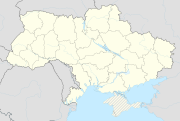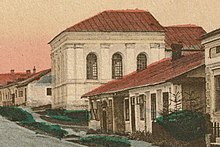Zassiv
| Zassiv | ||
| Сасів | ||

|
|
|
| Basic data | ||
|---|---|---|
| Oblast : | Lviv Oblast | |
| Rajon : | Zolochiv Raion | |
| Height : | 272 m | |
| Area : | 1.853 km² | |
| Residents : | 761 (2011) | |
| Population density : | 411 inhabitants per km² | |
| Postcodes : | 80713 | |
| Area code : | +380 3265 | |
| Geographic location : | 49 ° 52 ' N , 24 ° 57' E | |
| KOATUU : | 4621886401 | |
| Administrative structure : | 9 villages | |
| Address: | 80713 с. Сасів | |
| Statistical information | ||
|
|
||
Sassiw ( Ukrainian Сасів ; Russian Сасов Sassow , Polish Sasów ) is a village in Lviv Oblast in western Ukraine .
geography
The village is located on the left bank of the Western Bug in Zolochiv Raion in the east of Lviv Oblast, 75 km east of the Oblast capital Lviv . The international trunk road M 06 runs 10 km north of the village and the national trunk road N 02 runs about 10 km south of the village .
In addition to the main village, the district municipality of Sassiv also includes the villages Bir (Бір), Hrabowo (Грабово), Hutyschtsche (Гутище), Papirnja (Папірня), Pissok (Пісок) (), Chome Pobitsch (Побочо), Chome Pobitsch (Пешясок), and Chome Pobitsch (ПобіХо). .
history
The village was founded in 1615. King Sigismund III. granted the city a lot of autonomy and gave its merchants numerous privileges, and he also set up market days there. In 1726 Jakob Sobieski , son of King John III. Sobieski , the Jewish residents of Sasów various rights. In this way, all municipal institutions of the Jewish community were exempt from taxes. They were allowed to produce and sell alcohol, and their taxes were no higher than those of the rest of the townspeople. The Jews made candles and decorative strips for Tallit , for the production of which Sassiv was a world center. The best-known Jew in the market town was the founder of a Hasidim dynasty in Sasów, Rabbi Moshe Leib Erblich ( Sassow-Hasidim ).
Since 1776 the place under its Polish name Sasów was part of the Austrian crown land of Galicia and from 1867 belonged to the district administration Złoczów, after the end of the First World War it came to Poland in 1921 and was in the Tarnopol Voivodeship .
On September 17, 1939, the Red Army marched into Sassiv, which was administered by Soviet authorities until the German-Soviet War . The Wehrmacht occupied the village on July 2, 1941. During the first two weeks of the occupation, 22 leaders of the Jewish community were executed on the grounds that they were communists. There were three deportations; including the largest on July 15, 1942, when the Jews were deported to the Belzec extermination camp . The remaining 400 Jews were deported to Zloczów on November 25, 1942 . A labor camp established in March 1942 was disbanded in July 1943 and the Jews were shot in the nearby woods. With that, the Jewish community of Sassiv ceased to exist and was not re-established after the war.
During the Soviet occupation in 1940, the place was given the status of an urban-type settlement , but this was revoked in the 1950s after the decline of the place.
Demographics of the Jewish population
In 1764 there were 223 Jews in Sassiv, in 1880 there were 1906, in 1912 1761 (52.1% of the population) and in 1921 there were 1,096 (35.4%) Jews in the village. Before 1939 there were about 1,500 Jews in Sassiv.
Buildings
lock
There are remains of the castle.
Church of the Nativity of Saint John the Baptist
The Roman Catholic Church of the Birth of St. John the Baptist was built in 1864 in neo-Gothic style, a previous building had existed since 1631. The sculpture of the head of John the Baptist is located in the church. The last pastor of the church was deported to Poland with some Polish families in 1946. The church is open to parishioners on public holidays.
St. Nicholas Church
The church was probably built in 1731, so the inscription "1731" is on the door post of the St. Nicholas Church. However, some sources give the 15th century as the date of construction. In the middle of the 18th century it was redesigned as a baroque church with domes. The interior of the church shows icons from the second half of the 17th century. The following icons: "Flight into Egypt", "Christ and the Samaritan", "George the Victorious" (1681), "The delivery of the relics of St. Nicholas" (1685). In 1963 the Nikolaus Church was placed under monument protection. Since 1990 the church has belonged to the Greek Catholic community.
Synagogues
There were several synagogues in the village, including a wooden synagogue from the 18th century that has not been preserved.
Personalities
- Mosche Leib Erblich (1745–1807) founder of the Sassow-Hasidim, rabbi and author.
- Jan Stepa (1892–1959), Bishop of Tarnów
- Jitzchak Werfel (1914–1999), Israeli minister
- Kazimierz Kałucki (* 1935 in Sassiw; † 2005 in Stettin ), Polish technical chemist, professor at the Technical University of Stettin
Web links
- Entry on the place in the Encyclopedia of the History of Cities and Villages of the Ukrainian SSR (Ukrainian)
- Sasów . In: Filip Sulimierski, Władysław Walewski (eds.): Słownik geograficzny Królestwa Polskiego i innych krajów słowiańskich . tape 10 : Rukszenice – Sochaczew . Walewskiego, Warsaw 1889, p. 333 (Polish, edu.pl ).
- Jewish Virtual Library
- Gesher Galicia
- Castles
Individual evidence
- ^ Reichsgesetzblatt of January 23, 1867, No. 17, page 51
- ↑ Demography of the Jewish population on jewishvirtuallibrary.org accessed on August 19, 2013 (English)
- ↑ translated from uk: Сасів # Замок
- ↑ translated from uk: Сасів # Миколаївська церква
- ↑ Maria and Kazimierz Piechotka: Heaven's Gates. Wooden synagogues in the territories of the former Rzeczpospolita of Poland and Lithuania. Polish Institute of World Art Studies & POLIN Museum of the History of Polish Jews, Warsaw 2015, ISBN 978-83-942048-6-0 .
Remarks
- ↑ The Polish Wikipedia has an article on Kazimierz Kałucki .




